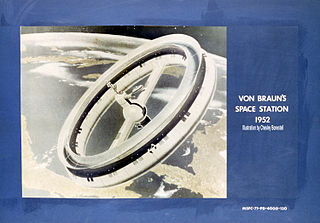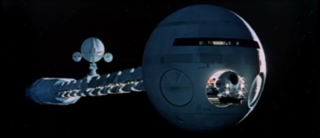
USS Voyager(NCC-74656) is the fictional Intrepid-class starship which is the primary setting of the science fiction television series Star Trek: Voyager. It is commanded by Captain Kathryn Janeway. Voyager was designed by Star Trek: Voyager production designer Richard D. James and illustrator Rick Sternbach. Most of the ship's on-screen appearances are computer-generated imagery (CGI), although models were also sometimes used. The ship's motto, as engraved on its dedication plaque, is a quote from the poem "Locksley Hall" by Alfred, Lord Tennyson: "For I dipt in to the future, far as human eye could see; Saw the vision of the world, and all the wonder that would be."

Artificial gravity is the creation of an inertial force that mimics the effects of a gravitational force, usually by rotation. Artificial gravity, or rotational gravity, is thus the appearance of a centrifugal force in a rotating frame of reference, as opposed to the force experienced in linear acceleration, which by the equivalence principle is indistinguishable from gravity. In a more general sense, "artificial gravity" may also refer to the effect of linear acceleration, e.g. by means of a rocket engine.
Shuttlecraft are fictional vehicles in the Star Trek science fiction franchise built for short trips in space, such as between a planetary surface and orbit. Also referred to as shuttles, their introduction preceded the development of the Space Shuttle.

Ratchet & Clank: Going Commando, known as Ratchet & Clank 2: Locked and Loaded in Australia and most PAL countries, is a 2003 third-person shooter platform video game developed by Insomniac Games and published by Sony Computer Entertainment for the PlayStation 2. It is the second game in the Ratchet & Clank series, following Ratchet & Clank. David Kaye reprises his role as Clank while James Arnold Taylor replaces Mikey Kelley as Ratchet.

Ratchet & Clank is a third-person shooter platform video game developed by Insomniac Games and published by Sony Computer Entertainment for the PlayStation 2 in 2002. It is the first game in the Ratchet & Clank series and the first game developed by Insomniac to not be owned by Universal Interactive.
"The Cloud" is the sixth episode of the television series Star Trek: Voyager. The teleplay was written by Tom Szolosi and Michael Piller, based on a story by Brannon Braga, and directed by David Livingston.
A space dock is a hypothesised type of space station that is able to repair or build spacecraft similar to maritime shipyards on Earth. They remove the need for new spacecraft to perform a space launch to reach space and existing spacecraft to make an atmospheric entry and landing for repair work. They currently only exist in fiction, however concept work has been undertaken on real space dock facilities that could be built with current technology.
"Timescape" is the 151st episode of the American science fiction television series Star Trek: The Next Generation, and the 25th episode of the sixth season.

Ratchet & Clank: Size Matters is a 2007 third-person shooter platform video game developed by High Impact Games and published by Sony Computer Entertainment for the PlayStation Portable. A spin-off of the Ratchet & Clank series, it is the first game in the series to be released for a handheld console. Developer High Impact Games consisted of former employees of series creator Insomniac Games. A port to the PlayStation 2 was released the following year.

Ratchet & Clank Future: Tools of Destruction is a 2007 third-person shooter platform video game developed by Insomniac Games and published by Sony Computer Entertainment for the PlayStation 3. It is the fifth main installment of the Ratchet & Clank series and the first to not be released on the PlayStation 2 or PlayStation Portable. It is the first installment of the series' Future saga. It was also one of the first PlayStation 3 games to support DualShock 3 rumble without any accessories.
"The Disease" is the 111th episode of the science fiction television series Star Trek: Voyager, the 16th episode of the fifth season. It focuses on a plot with Harry Kim as USS Voyager encounters a unique civilization on an extremely large starship.

Ratchet & Clank is a series of action-adventure platform and third-person shooter video games created and developed by Insomniac Games and published by Sony Interactive Entertainment. High Impact Games developed two installments for the PlayStation Portable while other studios were involved in remasters and ports. The series was exclusive to PlayStation consoles until Rift Apart received a Windows port in 2023. An animated feature film adaptation was released in 2016 alongside a reimagining of the original game; the main series effectively went on a 8-year hiatus and skipped the PlayStation 4 generation until the release of Rift Apart on the PlayStation 5.

A rotating wheel space station, also known as a von Braun wheel, is a concept for a hypothetical wheel-shaped space station. Originally proposed by Konstantin Tsiolkovsky in 1903, the idea was expanded by Herman Potočnik in 1929, and popularized by Wernher von Braun in 1952.

The United States Spacecraft Discovery One is a fictional spaceship featured in the first two novels of the Space Odyssey series by Arthur C. Clarke and in the films 2001: A Space Odyssey (1968) directed by Stanley Kubrick and 2010: The Year We Make Contact (1984) directed by Peter Hyams. The ship is a nuclear-powered interplanetary spaceship, crewed by two men and controlled by the AI on-board computer HAL 9000. The ship is destroyed in the second novel and makes no further appearances.

Ratchet & Clank Future: A Crack in Time is a 2009 third-person shooter platform video game developed by Insomniac Games and published by Sony Computer Entertainment for the PlayStation 3. It is the seventh main installment in the Ratchet & Clank series and the third in its Future saga.
The Star Trek franchise features many spacecraft. Various space vessels make up the primary settings of the Star Trek television series, films, and expanded universe; others help advance the franchise's stories. Throughout the franchise's production, spacecraft have been depicted by numerous physical and computer-generated models. Producers worked to balance often tight budgets with the need to depict convincing, futuristic vessels.

Ratchet & Clank: Into the Nexus is a 2013 third-person shooter platform video game developed by Insomniac Games and published by Sony Computer Entertainment for the PlayStation 3. It is the eighth main installment in the Ratchet & Clank series and the fourth and final installment of its Future saga. The series is noted for the inclusion of exotic and unique locations and over-the-top gadgets, elements of the traditional Ratchet & Clank experience that return in this game.

Ratchet & Clank is a 2016 third-person shooter platform video game developed by Insomniac Games and published by Sony Interactive Entertainment for the PlayStation 4. It is a tie-in to the 2016 film of the same name, as well as a reimagining of the first game in the series. The game was originally planned to be released in 2015, but was delayed, along with the film, to April 2016 in order to give the film a better marketing campaign and the game additional polish time.

Ratchet & Clank: Rift Apart is a 2021 third-person shooter platform video game developed by Insomniac Games and published by Sony Interactive Entertainment for the PlayStation 5. The ninth main installment in the Ratchet & Clank series, it serves as a sequel to Ratchet & Clank: Into the Nexus (2013). A port for Windows, developed by Nixxes Software, was released on July 26, 2023, marking the main series' debut outside a PlayStation console. The game received positive reviews from critics, with particular praise given to its visuals, combat, and technical advancements. It had sold over 3.97 million units by June 2023.












